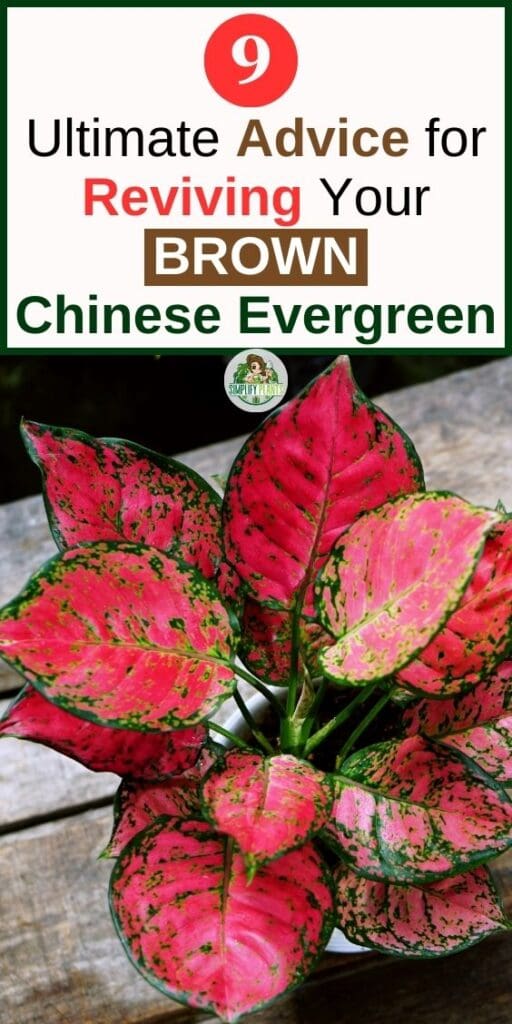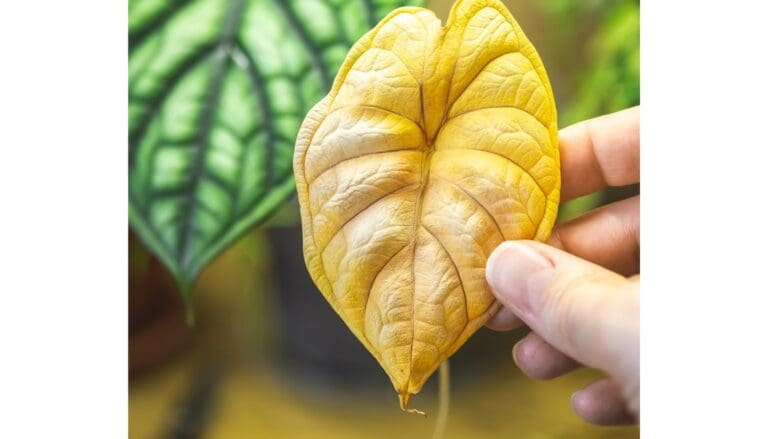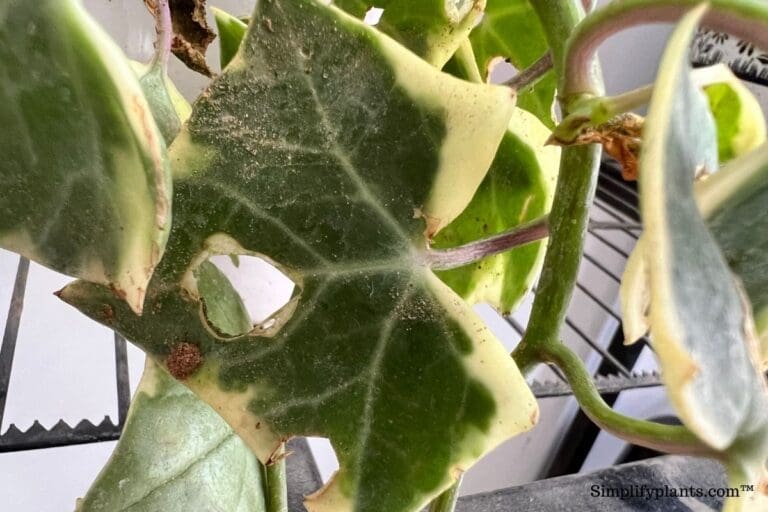10 Reasons Why Your Chinese Evergreen Is Turning Brown
Chinese evergreen or aglaonema is a popular tropical plant loved for its unique leaves and low-maintenance nature. However, Chinese evergreen might have a problem of brown leaves while experiencing problems similar to other houseplants.
In this article, we shall learn why is your Chinese evergreen turning brown and how you can fix the same.
The primary cause of brown leaves in Chinese evergreen plants is overwatering, exposure to direct sun, and overfertilization. While overwatering leads to root rot which results in completely brown leaves, overfertilization leads to brown tips, and exposure to direct sun leads to brown spots.
The appearance of brown leaves indicates that you have missed the initial signs of the problems, and you need to act fast to save the plant.
In this article, I will take you through all the possible reasons behind your Chinese evergreen turning brown and the ways of helping the plant recover from these problems.

Please note: Simplify Plants is reader-supported. Some links in the post are affiliate links and I get a commission from purchases made through links in the post.
Why is my Chinese evergreen turning brown?
Noticing brown leaves on any houseplant is not uncommon. However, it does mean that you don’t have an entirely healthy plant, and it requires some attention from your end.
Various reasons can lead to brown leaves on your Chinese evergreen. Some of the reasons are:
- Direct sunlight
- Overfertilization
- Low humidity
- Overwatering
- Underwatering
- Poor water quality
- Pest infestation and diseases
- Temperature fluctuations
- Repotting stress
- Aging
Before you start wondering which might be the exact reason behind the brown leaves on your Chinese evergreen, let’s discuss each of these in detail.
Direct sunlight

Chinese evergreen is a tropical plant used to dappled sunlight in its natural environment. It is an ideal houseplant because it doesn’t require direct sunlight for growth.
Chinese evergreen plants thrive under indirect bright sunlight, but direct sunlight can cause significant harm to the plant. One sign of direct sun exposure is brown leaves.
If the plant is exposed to direct sunlight, the upper leaves exposed to the sun get scorched and start getting discolored. These leaves can become dry and brown over time.
How to fix this?
The easiest way to identify browning due to direct sunlight is that the upper leaves will turn brown, while the lower leaves that are not exposed to direct sunlight will remain unaffected.
If you notice this on your Chinese evergreen, you must first relocate the plant to where it doesn’t receive any direct sunlight.
Then you must remove the brown and discolored leaves from the plant.
Give the plant a good soak if the soil has gone dry and let it recover. Avoid fertilizing till the plant recovers.
Also read: How Much Light Does A Chinese Evergreen Need? (Light Requirements)
Overfertilization

The Chinese evergreen or Aglaonema is a light feeder and doesn’t require excess fertilization. Fertilizing the plant during the growing season is sufficient for its growth.
However, the plant can get overfertilized if you fertilize it with a strong dose or fertilize it during the winter.
Overfertilization causes a salt build-up in the soil. The roots soak up the excess salt along with the water and send it to all parts of the plant.
The leaves react to this excess salt by showing brown tips or edges on leaves.
How to fix an overfertilized Chinese evergreen?
If your Chinese evergreen is overfertilized, you must first remove the affected parts.
Take the Chinese evergreen out of its pot and check if the roots are affected. If the old soil contains too much fertilizer, you might need to repot the plant using a fresh potting mix.
If the roots are affected, you need to remove the damaged roots and report the plant.
However, if the salt build-up is minor, you can scrape off the top layer of the soil. Avoid fertilizing till you notice new growth on the plant.
Also read: Does Chinese Evergreen Plant Needs Fertilizer? (How Often+Best Fertilizer)
Low humidity
Like most tropical plants, Chinese evergreen prefers high humidity. It thrives in humidity levels of 60-70%.
However, many households don’t have sufficient humidity, due to which the tropical plants undergo various problems. One search problem is round leaves.
If your Chinese evergreen doesn’t receive enough humidity, its leaves will lose all moisture and thus turn brown and dry.
How to provide more humidity to Chinese evergreen?

If the leaves of your Chinese evergreen a turning brown due to low humidity, you must find a way to increase the humidity.
To provide more moisture to the plant, you can take the help of:
- A humidifier
- A pebble tray
- An aquarium
- Grouping your Chinese evergreen with other tropical plants
- Relocating the plant to the bathroom
- Misting the plant
A humidifier is the easiest and an efficient way to increase humidity among all the above options.
Also read: Should I Mist My Chinese Evergreen? (+Humidity Guide)
Overwatering
A widespread problem found in all houseplants is overwatering. Brown leaves are a sign of an overwatered Chinese evergreen, but it means that you have been overwatering the plant for a prolonged period.
Chinese evergreen requires sufficient water to keep the soil moist, but it can’t tolerate waterlogged soil. When the Chinese evergreen plant sits in water for too long, the roots get suffocated due to the excess water.
The excess water stops the oxygen flow into the roots, due to which they start decaying, and the plant is hit by root rot.
Since the roots stop functioning and send water and nutrients to all the plant’s parts, the leaves become unhealthy, lose color, turn yellow and brown.
How to save an overwatered Chinese evergreen?
If your Chinese evergreen is overwatered, you must stop watering immediately and treat the plant.
In the initial stages, leaving the plant in the bright indirect sunlight after removing the excess water helps the plant recover. But in the later stages, you need to take the plant out to inspect the roots.
If the roots are healthy, you can spread the soil on a piece of paper and let it dry under bright sunlight.
But if you notice decaying roots, you’ll need to prune the damaged ones and repot the Chinese evergreen in a new pot with fresh potting mix.
You must let the plant recover from the overwatering stress, after which you can resume watering.
Underwatering

You can underwater your Chinese evergreen if you are ignorant or forgetful about watering it. Although Chinese evergreen is a low-maintenance plant, it doesn’t mean you won’t provide sufficient water.
The Chinese evergreen prefers evenly moist soil. If you let the soil go dry and don’t water when the plant needs it, you will soon have a dry plant.
The leaves will turn dry and brown due to lack of moisture and eventually fall off the plant.
How to revive an underwatered Chinese evergreen?
The crisp brown leaves n your Chinese evergreen indicate that the plant is underwatered, and you need to revive it from that state.
You can revive a dry Chinese evergreen by watering it. Yes, it’s that simple. If the soil seems too dry, you can take the plant out of the pot, place it in a container full of water, and let the soil soak up that water.
If you don’t want to take the plant out of its pot, give some water to it and wait for the soil to soak it up. Once the soil absorbs that water, you can water thoroughly and let the excess water drain out of the drainage holes.
Also read: How Much Water Does A Chinese Evergreen Need? (How Often+Summer & Winter)
Poor water quality
Most houseplants are sensitive to harsh minerals often found in regular tap water. If you notice brown spots on your Chinese evergreen leaves, watering the plant with tap water might be the reason.
Regular tap water contains minerals such as chlorine, fluorine, and bicarbonates that are not suitable for your Chinese evergreen.
How to provide good quality water to the Chinese evergreen?
If you have been watering your Chinese evergreen with tap water, you need to stop.
You can use rainwater or filtered water to water your Chinese evergreen. Or you can fill a bucket with tap water and leave it overnight to let the minerals dissipate. You can then use this water on your Chinese evergreen.
You must also avoid watering the leaves when you water your Chinese evergreen.
Pest infestation and diseases

Overwatering the Chinese evergreen can make it vulnerable to pests and other bacterial and fungal diseases.
The common pests that attack the Chinese evergreen are mealybugs, thrips, whiteflies, and spider mites. Spider mites will attack the plant if it is underwatered or doesn’t get enough humidity.
When your Chinese evergreen is infected with any pest, the plant will become weak as these pests absorb all the nutrients from the plant and cause severe damage.
Without enough nutrients, all the parts of the plant develop problems. It is not unusual to spot brown leaves in such conditions.
Diseases such as edema, powdery mildew, mold, and root rot can also cause the browning of the leaves in your Chinese evergreen.
How to treat pest infestation and diseases?
If you think your Chinese evergreen has a pest infestation, you must isolate it from other plants and inspect it to find out which pest has attacked the plant.
If the breasts are visible, you can use your hands to remove them from the plant. Or dip a cotton ball in alcohol and wipe the areas with pest infestation.
Spraying a Neem Oil solution on the Chinese evergreen plant might help treat all kinds of pest infestations.
You can spray fungicide on your Chinese evergreen to prevent and treat diseases. Don’t forget to remove the affected leaves and stems.
Also read: Do Chinese Evergreen Get Bugs? (Common Bugs+How To Get Rid Of Them)
Temperature fluctuations
Most houseplants, including the Chinese evergreen, don’t prefer temperature fluctuations. These plants prefer warm temperatures, and stable room temperature suits them well.
However, if you place your Chinese evergreen in areas with temperature fluctuations, the plant will get stressed and notice different issues such as ground leaves.
How to protect Chinese evergreen from temperature fluctuations?
Follow these if you don’t want to cause stress to your Chinese evergreen due to temperature fluctuations.
- Don’t place the plant near windows and doors that are opened and closed frequently.
- Keep the plant away from radiators, fireplaces, or other heating sources.
- Keep your Chinese evergreen away from frosty windows during winter.
- Don’t expose the Chinese evergreen to hot or cold drafts.
- Don’t expose the plants to the direct air of the AC.
- Avoid taking the plant outside when the temperatures are lower or higher than its requirements.
Also read: How Cold Can Chinese Evergreens Tolerate? (Chinese Evergreen Cold Tolerance)
Repotting stress

Chinese evergreen has a Shallow root system and requires repotting once in 3 to 4 years when it gets rootbound. However, repotting always comes with some stress.
All plants get used to living in their pots and go through some level of stress every time you take it out of the pot and repot it in a new one with fresh soil.
Your Chinese evergreen might also go through some stress after repotting, leading to yellow or brown leaves on the plant.
How to reduce the repotting stress for the Chinese evergreen?
You can neither avoid repotting nor take the stress away from your Chinese evergreen, but you can try to reduce the stress by taking care of the plant.
Place your Chinese evergreen in a bright spot where it gets indirect light, provide adequate water to keep the soil moist, and avoid fertilizing until you notice new growth.
Also read: When To Repot Chinese Evergreen? (Signs, Essential Supplies+How To)
Aging
Many times, the brown leaves on your Chinese evergreen are simply the result of aging. All the leaves have a certain lifespan, and when that is over, the leaves die.
So before the leaves die and fall off your Chinese evergreen plant, they might change color and turn yellow or brown.
It is a natural process and not something you need to worry about. As the old leaves turn brown and fall off, the plant will have more space for new growth.
Final words

Brown leaves are not uncommon and are a prevalent problem of all houseplants. However, if you take care of your Chinese evergreen by providing the correct living conditions, you can prevent brown leaves.
Place the Chinese evergreen in a bright area where it receives enough indirect light, water it after checking the moisture level to avoid overwatering it, fertilize it during the growing season with a diluted dose to remain healthy. You can also spray neem oil solution on the plant to protect it from pests and diseases.
A little attention and the proper knowledge of caring for the Chinese evergreen can go a long way and save the plant from brown leaves.
Reference: Wikipedia, Nasa clean air study, Missouri Botanical Garden, The University of Kansas, NC State University.
Recommended Garden Supplies
| Product Image | Our Recommended Gardening Supplies | Check Offers! |
|---|---|---|
Top Top
Top
Top
Top
Top
Top
Top
Top | rePotme Houseplant and Tropical Classic Potting Soil Mix | Check Offer On Amazon |
 Top
Top
Top
Top
Top
Top
Top
Top | Espoma Organic Indoor Plant Food | Check Offer On Amazon |
 Top
Top
Top
Top
Top
Top
Top
Top | GooingTop LED Grow Light 6000K Full Spectrum Clip Plant Growing Lamp | Check Offer On Amazon |
 Top
Top
Top
Top
Top
Top
Top
Top | Soil Moisture Meter | Check Offer On Amazon |
 Top
Top
Top
Top
Top
Top
Top
Top | Govee Hygrometer Thermometer, Bluetooth Enabled! | Check Offer On Amazon |
 Top
Top | LEVOIT Humidifiers for Large Room(Best For Plants) | Check Offer On Amazon |
 Top
Top
Top
Top
Top
Top
Top
Top | Upgraded DIY Automatic Drip Irrigation Kit, 15 Potted Houseplants Support | Check Offer On Amazon |
 Top
Top
Top
Top
Top
Top
Top
Top | Stainless Steel Heavy Duty Gardening Tool Set | Check Offer On Amazon |
 Top
Top
Top
Top
Top
Top
Top
Top | Bonide Insecticidal Soap | Check Offer On Amazon |
 Top
Top
Top
Top
Top
Top
Top
Top | Bonide 32 oz Spray Neem Oil for Organic Gardening | Check Offer On Amazon |
 Top
Top
Top
Top
Top
Top
Top
Top | Garden Safe Fungicide | Check Offer On Amazon |






